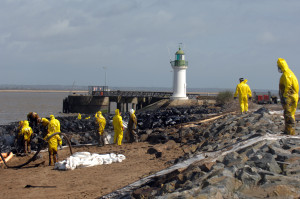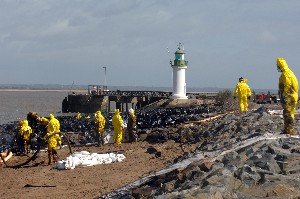While loading 31,000 m3 of bunker fuel in a ship, a leak in a refinery transfer hose resulted in a major oil spill in the Loire estuary.
At 4.10 pm, a person on a barge observed the presence of hydrocarbons on the water surface and sounded the alert. At around 4.45 pm, a roundsman identified and isolated the leak at 500 m upstream to where the hydrocarbons were detected.
The internal contingency plan was triggered at 5.00 pm and the inspection authorities of classified facilities were informed. A recovery ship was stationed at the mouth of the river while two trawlers recovered hydrocarbon pellets from the river.
The public ban on access to several beaches and fishing in the river that was in place subsequent to the spill was gradually lifted between the 4 and 18 of April. Over 750 people were involved for three and a half months in cleaning up the 90 km of polluted banks (6,170 tonnes of waste recovered and stored onsite before disposal). The operator bore the cost of 50 M euros to cover for the damage incurred, clean up and compensate effected businesses.
Investigations revealed that the leak was detected only after 5 hours leading to 478 tonnes of fuel being spilled of which 180 tonnes flowed into the Loire estuary.
A 16 cm² longitudinal breach caused by corrosion localised under the insulator was observed upon examination of the hose. The corrosion resulted from a water leak in the vertical pipe. Water seeped beneath the insulator, caused corrosion and subsequently caused the fuel pipe to rupture. Despite several defects detected the previous month on the same rack, the operator failed to revise this inspection programme to take into account the specific risks presented by this line given its proximity with the river banks. The effected fuel line was completely stopped and the inspections on the entire rack revealed several corrosion points on other lines that required repair.
The operator was required to implement several additional initiatives and measures:
- Extending inspection operations to other pipes in the site along with measurement of thickness at sensitive points (supports, spurs, etc.)
- Moving the layout of the service water mark so that it is not in a vertical position with respect to the insulated pipe
- Using a leak detection system along with a remote alarm in the control room to constantly monitor pipes located near the river
- Modifying the ground below the rack to channel any accidental spill to an adapted recovery network
- Installing a device to monitor the quantity of products leaving the tank and entering the corresponding transfer hose
It was also planned to consolidate the available emergency measures in the event of accidental pollution of the Loire river.
Download the detailed report in .pdf format (673 Kb)





